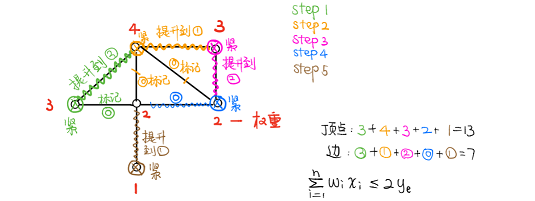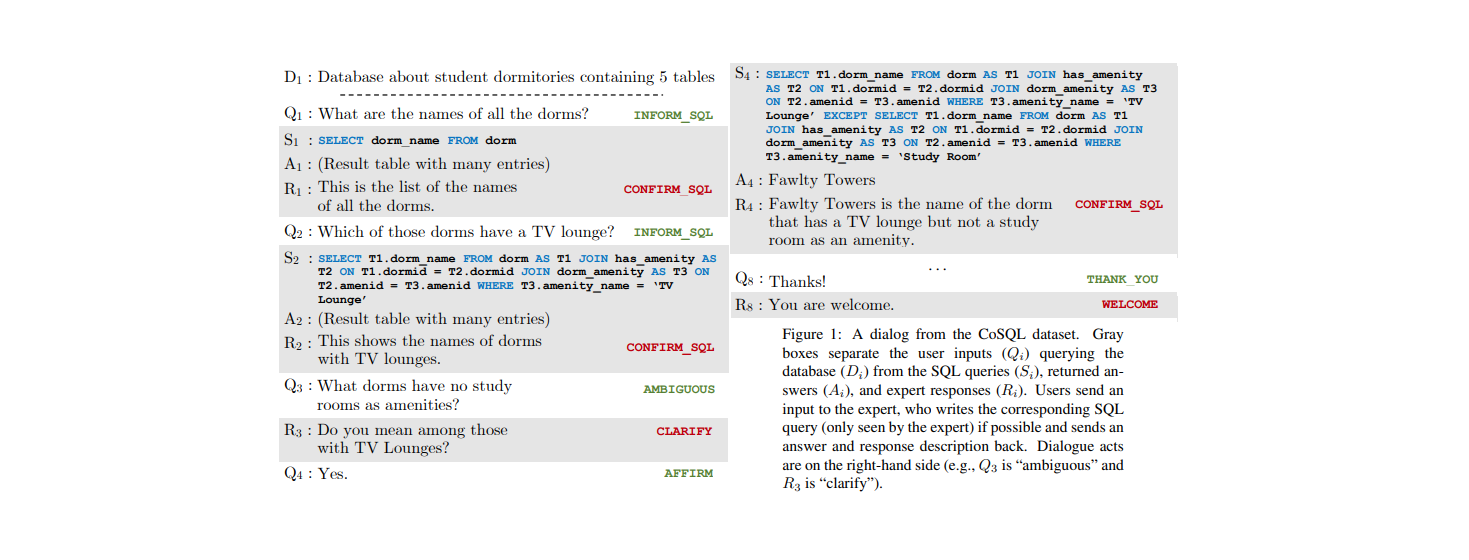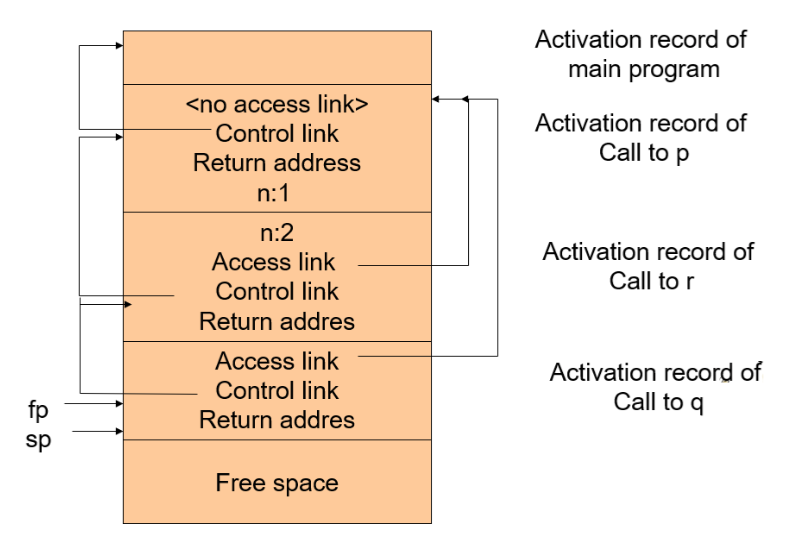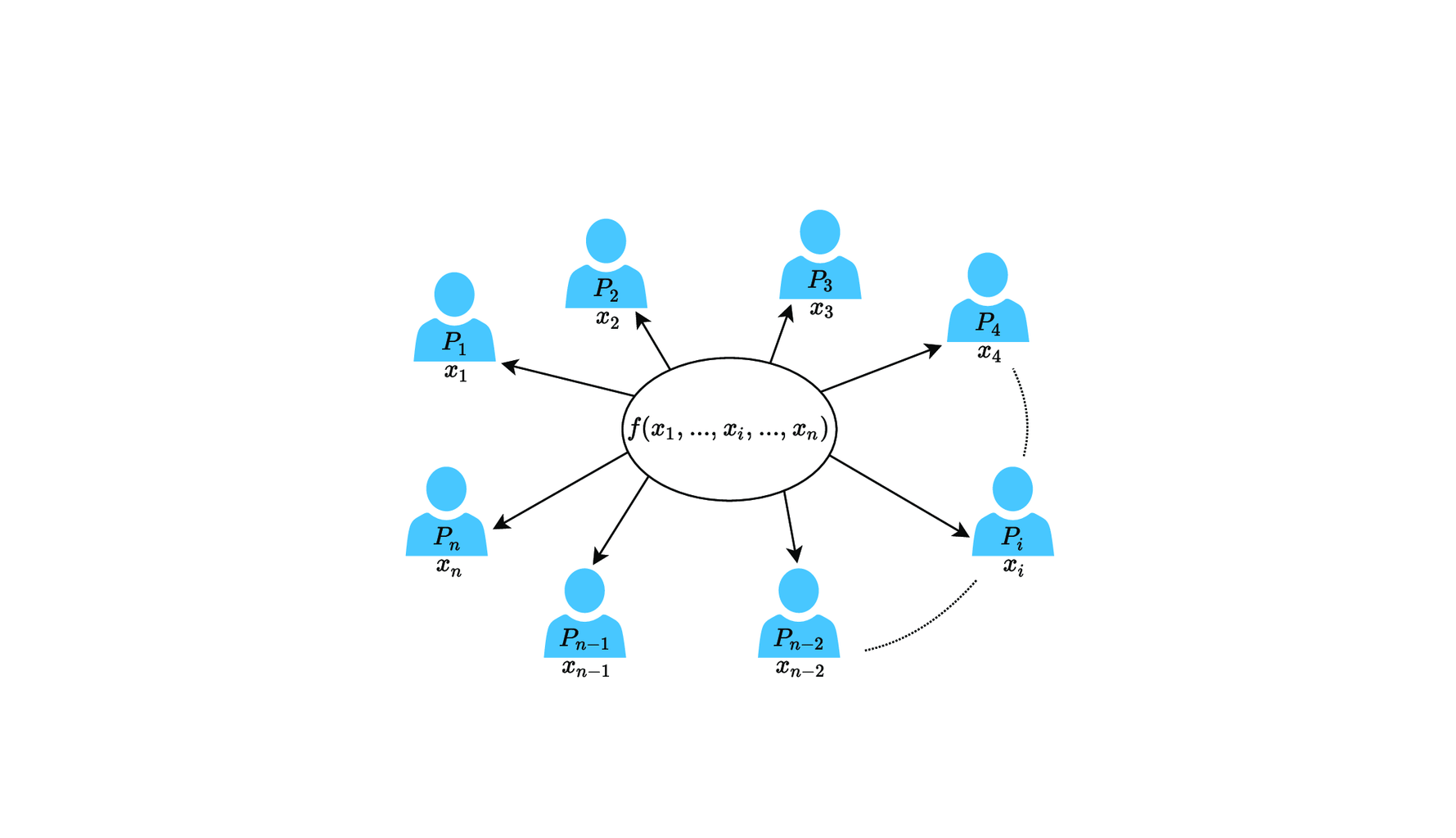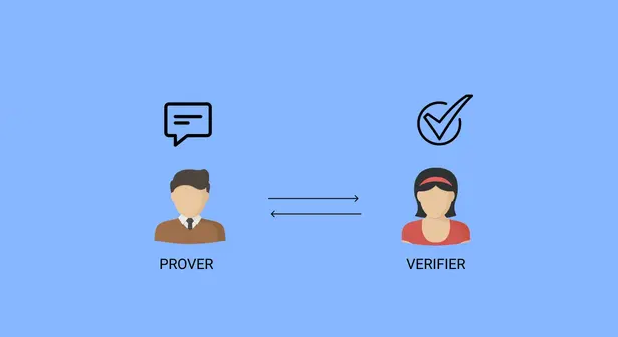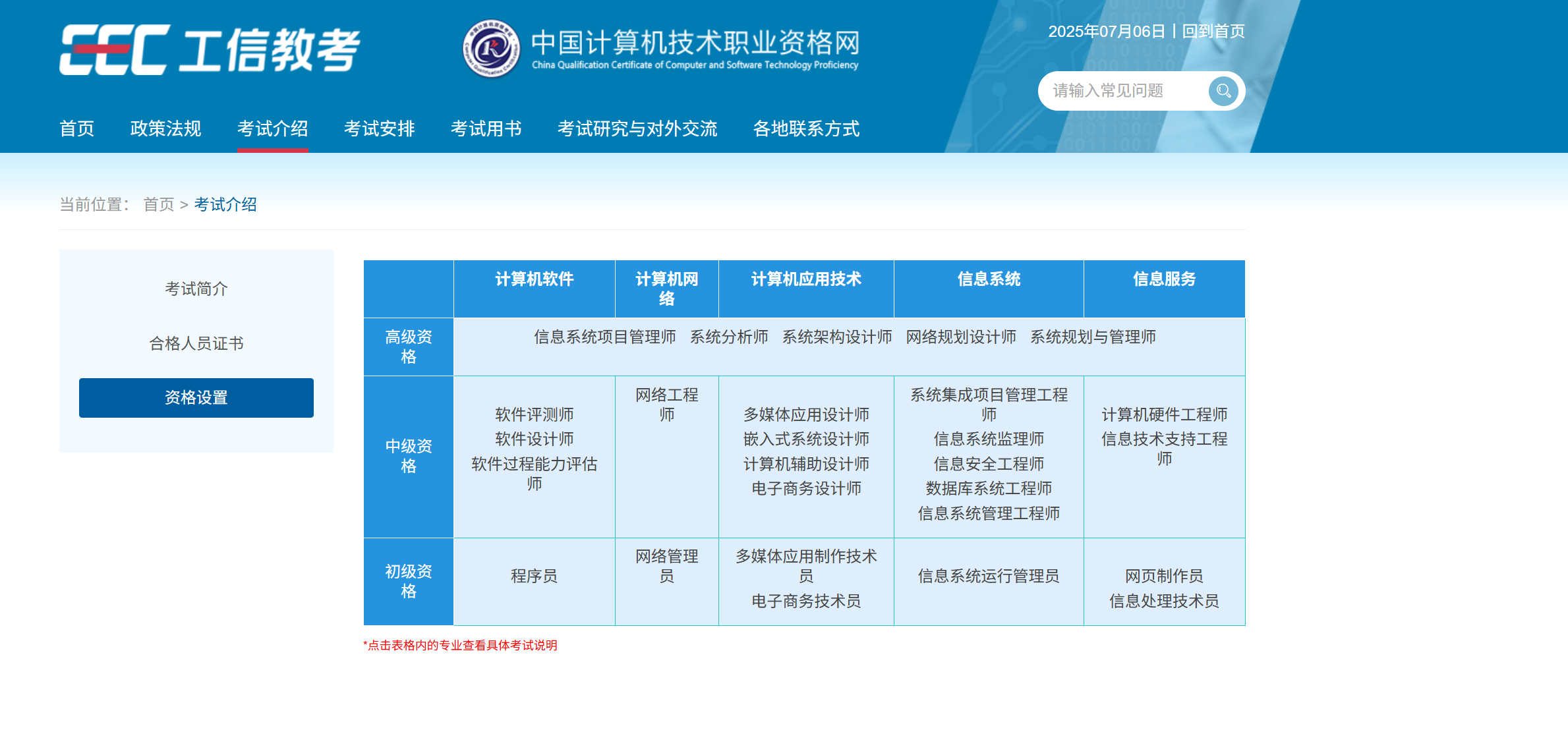《计算机网络》知识整理
计算机网络概述
- A protocol is an agreement between the communicating parties on how communication is to proceed.
- A protocol is a set of rules governing the format and meaning of the packets, or messages that are exchanged by the peer entities within a layer.
- A service is a set of primitives (operations) that a layer provides to the layer above it.
- Service interface defines which primitive operations and services the lower layer makes available to the upper one.
- Connection-oriented service 面向连接的服务
- Connectionless service 无连接的服务
- The OSI (Open Systems Interconnection) Reference Model OSI七层模型
- The TCP/IP Reference Model 五层模型
物理层 THE PHYSICS LAYER
| 通信方式 | 解释 |
|---|---|
| simplex system(单工通信) | 只有一个方向 |
| half-duplex system(半双工通信) | 通信双方都能发送和接受,但不能同时发送 |
| full-duplex system(全双工通信) | 通信双方可以同时发送和接受信息 |
- Signal 信号:数据的电气/电磁表现,是数据在传输过程中的存在形式。
- Bandwidth 带宽:The range of frequencies transmitted without being strongly attenuated.
- Symbol 码元:one of several voltage, frequency, or phase changes. Symbol/s = Baud
- data rate = symbol rate * bits per symbol
- Manchester encoding: data rate = symbol rate
- Nyquist Limit (noiseless)
- Max data rate: ,单位是 , 是 discrete levels.
- Max symbol rate:
- Shannon Limit (random noise)
- Max data rate:
- where is the signal to noise ratio.
- Max data rate:
- 信道
- 按传输信号的离散或连续划分为 数字信号(Digital Signal)和 模拟信号(Analog Signal)
- 按信道传输方式划分为 基带传输(Baseband Transmission)和 通带传输(Passband Transmission)
- Baseband: signal occupies frequencies from zero up to a maximum
- Passband: signal occupies a band of frequencies around the frequency of the carrier signal
- 编码和调制 Digital Modulation
- 设备
- 调制解调器(modulator demodulator)
- 调制:数字信号翻译成可沿普通电话线传送的模拟信号
- 解调:将模拟信号转回数字信号
- 编码解码器 (coder decoder):对一个信号或者一个数据流进行变换的设备或者程序。
- 调制解调器(modulator demodulator)
- PCM (Pulse Code Modulation)
- Baseband Transmission 基带传输
- Non-Return-to-Zero:高 低
- NRZI:翻转表示 ,不变表示
- Manchester Encoding:由 变 表示 ,由 变 表示
- Differential Manchester Encoding:异 同

- 4B/5B:不存在三个连续
- AMI:中间电平表示 ,高低表示

- Passband Transmission
- 振幅、频率、相位
- Constellation diagrams 星座图

- Digital Modulation and Multiplexing: Code Division Multiplexing
- 每一个 Station 有一个 的序列,任意两个序列正交。
- 编码时直接把发送信号的 Station 求和 。
- 解码时用当前 Station 的序列点乘 。
- 设备
- 数据传输
- GUIDED TRANSMISSION MEDIA 有线数据传输
- Magnetic media 磁介质
- Twisted pair 双绞线:可以同时传播数字信号和模拟信号。
- Coaxial cable 同轴电缆:抗干扰性比双绞线好,传输距离远,费用较贵。
- Fiber optics 光纤
- Multimode 多模:many different rays. Using LED.
- Unimode 单模: single rays, longer distance. Using Semiconductor laser
- WIRELESS TRANSMISSION 无线传输
- The Electromagnetic Spectrum 电磁波谱:频带越宽,速率越高。
- Microwave transmission 微波传输:发射塔越高,传播距离越远;广泛应用。
- Infrared and millimeter waves/Lightwave transmission 红外线和毫米波/激光
- GUIDED TRANSMISSION MEDIA 有线数据传输
- PUBLIC SWITCHED TELEPHONE SYSTEM 公用交换电话系统
- Switching offices
- Local loops: the wires between the customers and the switching offices: xDSL.
- Trunks: the long-distance connections between the switching offices: TDM & FDM.
数据链路层 THE DATA LINK LAYER
- 数据链路层的功能
- Providing a well-defined service interface to the network layer
- Dealing with transmission errors
- Regulating data flow so that slow receivers are not swamped by fast senders.
- services
- Unacknowledged connectionless service 无确认的无连接服务
- 适用于错误率很低的场景,如实时交通系统。
- Acknowledged connectionless service 有确认的无连接服务
- Useful for unreliable channels, such as wireless systems (WIFI).
- Acknowledged connection-oriented service 有确认的面向连接服务
- 面向连接一定有确认;在传输之前就建立了连接。
- Unacknowledged connectionless service 无确认的无连接服务
- 链路层发出的数据包称为 frame(帧),网络层发出的数据包称为 packet(包)。
- 从上到下,frame 就是在 packet 的前后加上 header 和 Trailer 后封装而成的。
- 从下到上,frame 就是在 bit stream 里分组截取出来的数据。
- 数据链路层分装成帧的策略
- Byte count 字符计数法:在 header 里声明总长度。
- Flag bytes with Byte Stuffing 在比特流的开头和结尾填充上固定的 串作为标识符。如果传输数据里也有 ,就在前面加上转义串 。
- Flag bits with bit stuffing:假设起始和终止的标识符都是 ,那么对于比特流中的内容,每遇到连续的五个 就在后面添一个 。
- physical layer coding violations 违规编码法:用不可能出现的电平变化作为开头结尾
- 比如在曼彻斯特编码中,低-高 表示 ,高-低 表示 ,则用 低-低 和 高-高 来声明。
- 差错的检测和纠正
- Parity 奇偶检验:检查出奇数个比特的错误,检错率
- Checksum:将比特流每隔 个分组,把得到的这些数字在模 域下相加,作为 位校验码。
- Cyclic Redundancy Check 循环冗余码:将传输数据的 串对一个固定的生成多项式取模,然后把传输数据和模数一起传过去,对面就可以拿生成多项式检验了。
- CRC-12:
- CRC-16:
- Hamming Code 海明码
- 为了检测 位错误,海明距离至少要是
- 为了纠正 位错误,海明距离至少要是
- 若比特流有 位,若要能纠正一位错误:
- 添加的 位校验位须满足:
- 在所有 的幂次的位置处插入校验位,剩余的位置按顺序摆放数据位。
- 第 个校验位的取值由所有下标里带 的数据位决定。要求那些位和校验位的异或值等于 。
- 接收方依次检查每一个 的异或值,如果非 就记下来。出错位就是非 位的叠加态。
- 数据链路层流量控制和传输机制
- Stop-wait Control 停止-等待协议:单工,每发完一组数据就停止发送,收到对方确认再继续发送。
- 接收方回复 ACK 表示已收到,回复 NCK 表示数据有误请求重传。
- 发送方设置一个 timer(超时计时器),若到期后仍未收到 ACK 就重新发送。
- 接收方会丢弃重复收到的帧,但是依然会发送 ACK(因为可能上一次 ACK 丢了)。
- Utilization:
- sliding windows protocol 滑动窗口协议,分为以下两种。Utilization:
- go back N Control 后退 N 帧协议:发送方用 Sliding Windows 发消息,接收方只有一个接受窗口。
- 采用 累计确认 的规则发送和接受 ACK。
- 当发送方的超时计时器超时,会一次性重传所有未被确认的帧。
- 若帧的编号的位数是 (最多有 种帧),滑动窗口的大小不能超过
- Selective Repeat Control 选择重传协议:发送方和接收方都用 Sliding Windows 收发消息。
- ACK 只会返回收到的帧的编号。发送方会保留所有还未被确认的帧,因为可能会重传。
- 若帧的编号的位数是 (最多有 种帧),滑动窗口的大小不能超过
- Stop-wait Control 停止-等待协议:单工,每发完一组数据就停止发送,收到对方确认再继续发送。
- Example Data Link Protocols: Point to Point Protocol
- send packets over the links, including the SONET fiber optic links and ADSL links
- A framing method
- A link control protocol 链路控制协议
- have a different NCP (Network Control Protocol, 网络控制协议)
介质访问子层 The Medium Access Control
- 这层可以视为数据链路层的子层(sublayer)
- LLC子层:负责识别网络层协议,进行封装;为网络层提供 services。
- MAC子层:数据帧的封装卸撞,帧的寻址识别;屏蔽了不同物理链路的差异。
- 两种网络类型:点对点(point-to-point),广播式(broadcast)
- 在广播式类型里,需要考虑信道分配问题,涉及到多路复用技术。
- Multiple Access Protocols 信道划分介质访问控制协议
- 静态信道划分 Static channel allocation
- 频分多路复用 Frequency Division Multiplexing
- 时分多路复用 TDM 统计时分复用 STDM
- 波分多路复用 WDM:传输不同波长的光波
- 码分多路复用 CDM
- 码分多址 CDMA:将不同设备的 和 编码成 位的包含 和 的向量,且两两正交。发送时同时把多个设备的码线性相加,接收的时候点乘上自己的码再除掉 即可得到比特。
| CSMA 类型 | Persistent CSMA | Non-persistent CSMA | -persistent CSMA |
|---|---|---|---|
| 信道空闲 | 马上发 | 马上发 | 概率马上发, 概率等待 |
| 信道忙 | 继续监听 | 一段时间后再监听 | 一段时间后再监听 |
- 动态信道划分 Dynamic channel allocation
- Pure ALOHA:不监听信道,不按时间槽发送,随机重发。
- 帧时 :发送一个标准长的帧所需的时间
- 吞吐率 :在一个帧时T内发送成功的平均帧数(, 时信道利用率 )
- :发送成功的帧在已发送的总帧中所占的比例
- 运载负载 :一个帧时T内所有通信站总共发送的帧平均值(包括原发和重发帧)
- 的推导:用泊松分布近似,一个帧时内发了 个帧的概率是 ,所以
- 所以 ,当 时
- Slotted ALOHA:时间被切成等长的片,要等到下一个时间片开始才能发送。
- , 当 时
- Carrier Sense Multiple Access 载波侦听多路访问协议(见上面表格)
- CSMA with Collision Avoidance
- 主动避免冲突,主要应用于无线网络。缺陷: hidden problem。
- 监听到信道空闲(idle)时,并不是立即发送,而是等待一段时间再发送数据。
- IEEE 802.11:监听到信道空闲的时候,先发送一个很小的信道侦测帧 Request-To-Send ,如果收到 目标地址的 Clear-To-Send 再发送数据。一定程度上缓解 hidden problem。
- CSMA with Collision Detection
- 在半双工网络中考虑问题(冲突仅为发送接收双方的碰撞),主要应用于有线网络。
- 若传播时延是 ,则最坏在 检测到冲突。
- binary exponential backoff 二进制指数退避算法:基本推迟时间是 ,从小到大枚举正整数 ,每次从 里选一个数 ,延迟 后发送。 放弃。
- 当帧长过短的时候 CSMA/CD 可能不会有用。能确保有用的最小帧长是
- Collision free protocols: A Bit-Map Protocol
- 如果想发送数据,Station 在 slot 时插入一个 。
- 按 bitmap 1的顺序发送数据。
- 设 是 slot 的长度, 是数据帧大小。
- At low load,
- At high load,
- Collision free protocols: Token Passing 令牌传递协议
- 令牌到来时如果消息队列非空,就放入令牌里
- Collision free protocols: Binary Countdown
- 每个 Station 如果要发送数据,先广播自己地址这个 bit string。
- 每单位时间,每个 Station 会收到所有 Station 地址这一位的 OR 值。
- 一旦某个 Station 发现自己这一位是 但是收到的是 (说明还有 high-order 的和他抢)就放弃。
- 这个做法相当于每次只允许地址最高的发送。
- Limited-Contention protocols: Adaptive Tree Walk Protocol 自适应树搜索协议
- Station 是一棵 binary tree 的叶子。从根开始,在每个时间槽询问左右两个子树的需求。
- 每次决策往那边走(左右都有先左),走 层便可确定本次发送数据的 Station。
- Pure ALOHA:不监听信道,不按时间槽发送,随机重发。
- 局域网(Local Area Network)
- 数据传输率高,延迟低,可靠性高;分布式控制和广播式通信。
- 拓扑结构:星型,总线型,环形,树形。
- 介质访问控制方法
- CSMA/CD:常用于总线型局域网
- 令牌总线(只有令牌持有者才能控制总线,才有发送信息的权利):常用于总线型局域网
- 令牌坏:用于环形局域网。
- Ethernet 以太网:应用最广泛的局域网。
- 两个标准:DIX Ethernet V2 或 IEEE 802.3
- Destination address and source address: 6 bytes each
- Unicast address, Broadcast address, Multicast address
- 传输字节: ,checksum 采用 32 位 CRC
- 标准以太网 10Mbps,快速以太网 100Mbps。
- 逻辑拓扑总线型,物理拓扑星型或拓展星型
- 造价低廉,应用最广泛;能满足网络速率的要求:10Mb/s-10Gb/s
- 使用CSMA/CD。无连接,不可靠。只实现无差错接受,不实现可靠传输。
- 每一个适配器对应一个唯一的MAC地址(48位)
- Wireless Local Area Network
- 采用 IEEE 802.11 标准,p-persistent CSMA
- Sublayer Protocol:DCM 分布协调功能;PCF 集中协调功能
- Data Link Layer Switching: Uses of Bridges
- Operation of a LAN bridge from 802.11 to 802.3.
- The first 802 bridge is a learning bridge or transparent bridge.
- 使用 backward learning 算法。
- 初始时有一张空的哈希表。
- 若 Station A 请求 Station B 时到了目前的 Bridge,查看 B 是否在哈希表里。
- 如果不在,采用 Flooding 遍历每个除消息源的端口,把消息都传一遍。
- 如果在,直接Forward 到目标端口。
- 同时把 Station A 的端口信息记录在哈希表里。
- 缺点:如果有环就会出问题,一般会搭 spanning tree 来工作。
网络层 THE NETWORK LAYER
-
DESIGN ISSUES
- Store-and-Forward Packet Switching 分组交换技术
- 收到 packet 后,进行验证、存储和转发,然后再送往下一个 router。
- Services Provided to the Transport Layer 为传输层提供的服务
- 路由技术与传输层独立;路由的数量、状态和拓扑结构对传输层隐藏。
- The network addresses made available to the transport layer should use a uniform numbering plan, even cross LANs and WANs
- Connection-less service 无连接服务
- 不需要提前建立连接。
- Packets are injected into the subnet individually and routed independently of each other.
- 每一个 packet 被称为 datagrams 数据报。子网络叫做 datagram subnet。
- Connection-oriented service 面向连接的服务
- 用 Virtual Circuit 虚电路技术 实现。
- 建立虚电路 数据传输(全双工通信) 释放连接
- 仅在建立阶段需要用到目的地址,后续每个节点会用虚电路号代替。保证分组有序转发。
- Store-and-Forward Packet Switching 分组交换技术
-
ROUTING ALGORITHMS 路由算法
-
按传播范围分类
- Unicast: point-to-point, one-to-one. eg. DV routing, LS routing
- Broadcast: one-to-all. eg. Flooding, Reverse path forwarding
- Multicast: one to many
- Anycast: one to any
- Collection: all-to-one. Used in sensor network
-
按是否动态分类
- Nonadaptive algorithms 非自适应算法:手动配置路由。应用于军事网络和小部分商业网络。
- Adaptive algorithms 自适应算法:按照路由算法实时优化路由表项。
-
一些指标:Hops 跳数,physical distance 物理距离,bandwidth 带宽,traffic 流量,cost,measured delay,mean queue length 平均队列长度
-
Distance Vector routing 距离矢量路由算法
- 每一个路由器都维护一张表,记录了到所有目的地的最短路以及对应的邻居(下一跳路由)。
- 这些表会通过邻居之间交换信息得到更新。
- DV算法对 good news 的反应迅速,但是对 bad news 收敛慢。
- 改进:Poisoned reverse 毒性逆转:如果 是通过 到达 的, 给 传信息时把到 的距离设为无穷大。不能完全解决坏消息收敛慢的问题;在链上可以解决。
- 对应 Routing Information Protocol RIP 协议,通过广播 UDP 报文交换路由信息。
-
Link State routing 链路状态路由算法
- 给邻居发 Hello packet,期望邻居回复以获取地址。
- 给邻居发 ECHO packet,要求快速返回消息,用 RTT 来度量 metric。
- 每个路由器建立 link state packet,依次包括 identity of the sender, sequence number, age, a list of neighbors (and costs to them)。每新建一个 pkt,sequence number 都会增加;age 表示有效时间,每隔一秒会减一,减到 后就无效。
- 用 Flooding 方式把 packet 传播到自治系统里的所有节点。
- 每个节点都能建立一张全网拓扑图,用 Dijkstra 算法来计算最短路。
- 对应 Open Shortest Path First OSPF 协议,直接采用 IP 交换信息。
-
Hierarchical routing
- 理论最优的层级结构是: 个 router 设置 层,平均每个路由器有 个连接。
-
Broadcast routing
- Sink-tree based broadcast 汇集树:只往生成树邻居 broadcast,最优。
- Reverse path forwarding 逆向路径转发:当一个广播分组到达一个路由器的时候,观察该线路是否就是该路由器往广播源发送的最优线路,如果是就保留转发,不是就丢弃。
-
-
Internetworking
- Tunneling 隧道:路由器不支持 IPv6,可以用 IPv4 包起来构成隧道。
- Autonamous System 自治系统:each network is operated independently of all the others
- Internet (inter-AS) / Intranet (intra-AS) routing: Exterior/Interior gateway protocol
- Fragmentation 分片;不能超过 MTU,每个必须是 字节的倍数。
-
IPv4 Protocol:无连接、不可靠
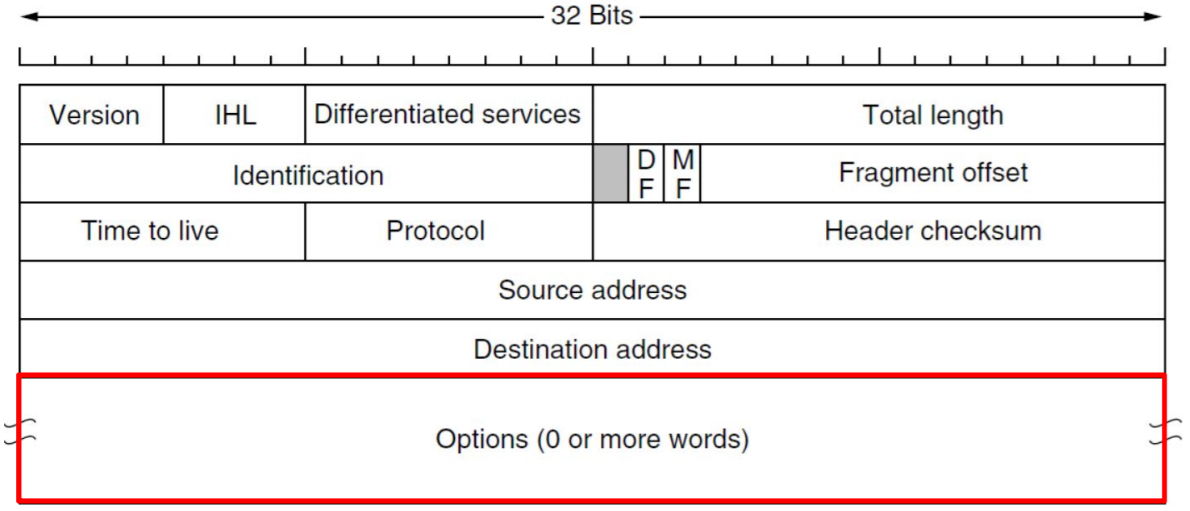
- Version:IPv4/6
- IHL:表示首部长度,单位是 4B。,即表示的最小长度是 20B。
- **differentiated services **:优先级。
- Total length:header 和 data 的总长度,单位是 1B。理论最大值是 65535,不过并达不到。
- Identification:当前 telegram 的 ID 号。被分片的数据拥有同一个数值。
- Don’t Fragment:DF=1 禁止分片;DF=0 允许分片。
- More Fragment:MF=1 后面还有分片;MF=0 最后一片/未分片。
- Fragment offset:目前分片在电报中的相对位置。单位是 8B。

- IP addressing
- Prefixes:Splitting an IP prefix into separate networks with subnetting.
- Classful and Special Addressing(见上图)
- Classless Inter-Domain Routing (CIDR):
+ 用 IP/Mask 表示一个地址。
+ IP 地址可以进行 Aggregation。
+ 路由器寻址时使用 Longest matching prefix。 - Network Address Translation(NAT)
- To assign each company a single IP address for Internet traffic.
- reserved private IPs:
- 10.0.0.0/8
- 172.16.0.0/12
- 192.168.0.0/16
- 对 NAT box 负责内外的 IP+Port 的翻译工作。
- NAT traversal problem: Since the mapping in the NAT box is set up by outgoing packets, incoming packets cannot be accepted until after outgoing ones.

- Relevant Protocols(左上图)
-
Internet Control Message Protocol ICMP 网际控制报文协议
- 路由器在处理 packets 时如果遭遇差错,会给 sender 一个 ICMP 错误报文(右上图)。
-
The Address Resolution Protocol ARP 协议
- 从 IP 地址到 MAC 地址的转换。
- 子网内:在子网内广播 ARP 请求分组,对应目标地址单播响应请求。
- 非子网内:先用 ARP 协议获得网关地址,路由器跳到目标网络,再用一次 ARP 获取目标地址。
-
Dynamic Host Configuration Protocol **DHCP **动态主机配置协议
- 即插即用的机制,主机可以从服务器动态获取 IP地址、子网掩码、默认网关。
- 属于应用层协议,使用客户/服务器方式,通过广播交互,基于 UDP。
- host broadcasts “DHCP discover” msg
- DHCP server responds with “DHCP offer” msg
- host requests IP address: “DHCP request” msg
- DHCP server sends address: “DHCP ack” msg
-
Border Gateway Protocol BGP 协议
- Exterior Gateway Routing Protocol

- 为保证可靠传输,采用 TCP 协议(放入 TCP 报文的字段里面)
- Exterior Gateway Routing Protocol
-

- IPv6
- 将地址从 位或占到 位,增加了扩展首部(提高路由器效率),校验和子段被移除(加速)。
- IPv6 支持即插即用,不需要 DHCP 协议。
- IPv4 的首部是 4B 整数倍,IPv6的首部是 8B 整数倍。
- 只能再主机处分片,不能在路由器分片了。
- 使用冒号十六进制记法。可以省略首位 。连续的十六进制 0 可以被压缩成两个冒号(最多一次)。
- 8000:0000:0000:0000:0123:4567:89AB:CDEF 或 8000::123:4567:89AB:CDEF
传输层 THE TRANSPORT LAYER
- The Transport Service
- 与网络层的服务类似,都是 Establishment data transfer release 的过程,都有 Addressing 和 Flow control。
- 区别:传输层完全应用于主机上,而网络层还应用于路由器上;传输层比网络层 更可靠。
- Primitives
- Hypothetical Primitives 见左图;现在广泛应用的 API 的是右图的 Berkeley Socket。

- Hypothetical Primitives 见左图;现在广泛应用的 API 的是右图的 Berkeley Socket。
- Elements of Transport Protocols
- Addressing
- NSAP: Network service access point IP (32 bit)
- TSAP: Transport service access point Port (16 bit)
- Connection Establishment
- …
- …
- Addressing
- RPC (Remote Procedure Call) : make a remote procedure call look as much as possible like a local one.
- User Datagram Protocol UDP协议
- 发送封装后的 IP 数据报,无连接服务。没有 flow control, error control 和 retransmission。
- UDP 协议首部的大小是 8 B。注意 UDP Length 是包括首部的(最小 20 B)。主要应用:RTP, DNS

- Real-time Transport Protocol RTP协议:RTP is to multiplex several real-time data streams onto a single stream of UDP packets and unicast or multicast the UDP packets.
- Transmission Control Protocol TCP协议
- 点对点的虚连接,可靠有序,不丢失不重复,全双工通信(full duplex)。
- 无结构的字节流:A TCP connection is a byte stream, not a message queue。
- TCP Header 的固定部分是 20B,可以额外加 options(注意填充成 4B 整数倍)。
- Window size: tell how many bytes may be sent starting at the byte acknowledged.
- Urgent pointer: indicate a byte offset at which urgent data are to be found.
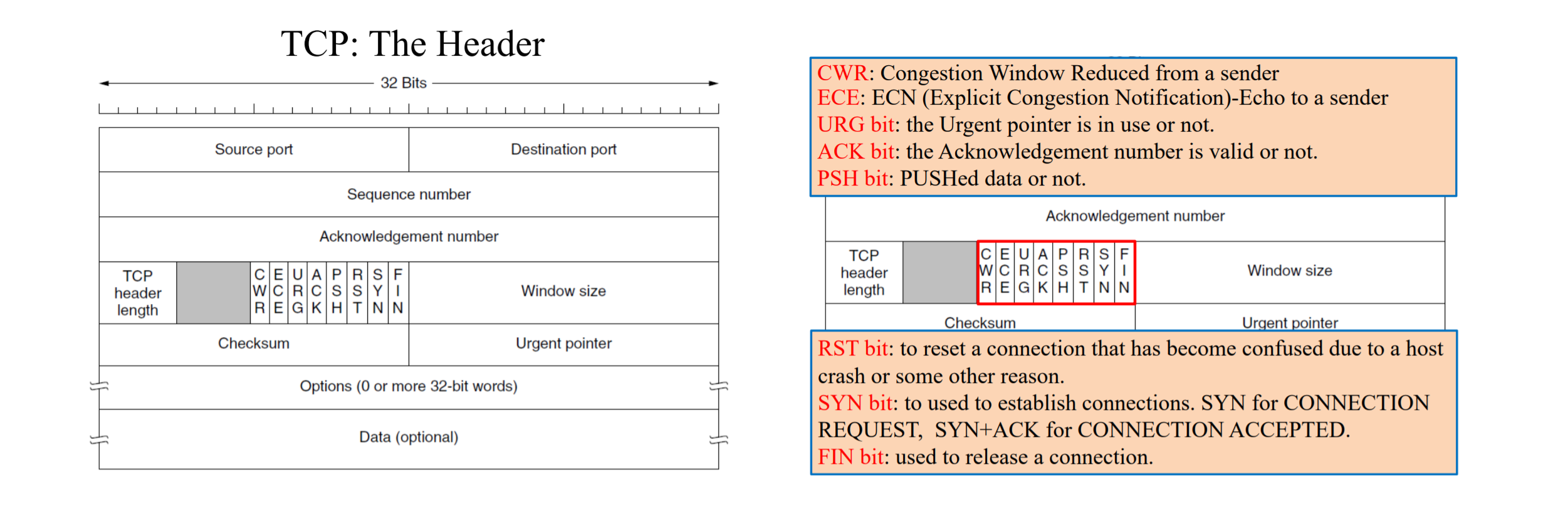
- Nagle’s algorithm: When data come into the sender one byte at a time, just send the first byte and buffer all the rest until the outstanding byte is acknowledged.
- Connection Management
- Establishment: Three-way Handshake
- SYN=1, SEQ=x
- SYN=1, SEQ=y, ACK=x+1
- SEQ=x, ACK=y+1
- Two-army problem: 若消息可能会被拦截,两军无法真正确认对方是否收到消息。
- Release: Four-Way Wavehand
- FIN=1, SEQ=u,此后发送方不再发送数据,并进入等待状态。
- ACK=u+1, SEQ=v,接收方可能还会正常发送消息。
- FIN=1, ACK=1, SEQ=w,接收方也发送了断开连接的请求。
- ACK=1, SEQ=u+1, ACK=w+1,发送方发送收到断开请求的确认信息。为了避免 Two-army problem,在等待一段时间后直接关机。
- Establishment: Three-way Handshake
- 采用 Sliding Windows 机制,
- Timer Management
- Retransmission Timer 重传计时器
- Smoothed Round-Trip Time. ()
- Round-Trip Time VARiation. ( )
- Retransmission TimeOut.
- Persistent Timer 坚持计时器。如果接收端从 窗口(禁止发送端发送)变回正常窗口的报文丢失,发送端会一直等待这个报文导致死锁。所以发送端被限制为 后,每隔一段时间发送一个确认信息。
- Keeplive Timer 保活计时器:检测另外一端是否是 live 状态。
- Retransmission Timer 重传计时器
- TCP Tahoe Congestion Control
- cwnd, Threshold, slow-start, congestion-avoidance

- cwnd, Threshold, slow-start, congestion-avoidance
- TCP Reno Congestion Control
- slow start: When cwnd is below Threshold, window grows exponentially.
- congestion-avoidance: When cwnd is above Threshold, window grows linearly.
- When a triple duplicate ACK occurs, Threshold set to cwnd/2 and cwnd set to Threshold.
- When timeout occurs, Threshold set to cwnd/2 and cwnd is set to 1 MSS.
应用层 THE APPLICATION LAYER
-
Domain Name System 域名服务
- Domain names are case insensitive, .
- The top-level domains come in two flavors
- generic (com, edu, gov, int, mil, net, org, biz, info, pro, aero, coop, museum, …)
- countries (cn, uk, …).
- A resource record is a five-tuple (Domain_name, Time_to_live, Class, Type, Value).
- An authoritative record is one that comes from the authority that manages the record and is thus always correct authoritative server.
- Cached records may be out of date.
- root name servers: There are root DNS servers, unimaginatively called a-root-servers.net through m.root-servers.net. They have information about each top-level domain.
- Example of a resolver looking up a remote name robot.cs.washington.edu in steps.

-
Email
- Message Format
- RFC 5322: The Internet Message format

- MIME (Multipurpose Internet Mail Extensions) message format
- international languages and media file.
- RFC 5322: The Internet Message format
- Message Transfer: SMTP = Simple Mail Transfer Protocol
- Final Delivery
- POP3 (Post Office Protocol v3): simple
- IMAP 4 (Internet Message Access Protocol v4): complex
- Webmail
- Message Format
-
WORLD WIDE WEB
- Architectural overview: Browser
- What is the page called? (Filename)
- Where is the page located? (DNS Name)
- How can the page be accessed? (HTTP, FTP, …)
- URL: Universal Resource Locator
- URL = protocol (http) + DNS name + path name
- URI (Uniform Resource Identifier)
- What does the browser do when one link is selected:
- The browser determines the URL (by seeing what was selected).
- The browser asks DNS for the IP address of www.zju.edu.cn.
- DNS replies with 210.32.0.9.
- The browser makes a TCP connection to port 80 on 210.32.0.9.
- It then sends over a request asking for file /home/index.html.
- The www.zju.edu.cn server sends the file /home/index.html.
- The TCP connection is released.
- The browser displays all the text in /home/index.html.
- The browser fetches and displays all images in this file.
- Architectural overview: Browser
-
HTTP (HyperText Transfer Protocol)
- RTT (ping time): the time it takes for a small packet to travel from client to server and then back to the client.
- HTTP: Connections
- HTTP 1.0 with multiple connections: 每个 TCP 只进行一次请求和回复。
- HTTP 1.1 with persistent connections (sequential requests) : 同一个 TCP 里请求和回复。
- HTTP 1.1 with persistent connections and pipeline requests: 一次可以多个请求回复。
- HTTP: Methods case sensitive

- HTTP has built-in caching support.
- First strategy: page validation.
- Second strategy: send a GET to server to ask.
NETWORK SECURITY
- Network security problems can be divided roughly into four intertwined areas
- Secrecy 机密性,Authentication 认证,Integrity 完整性
- Nonrepudiation 不可否认性 e.g. personal signature)
- Cryptography
- Substitution Ciphers & Transposition Ciphers
- One-Time Pads + quantum cryptography
- Kerchoff’s principle: all algorithms must be public while the key is secret.
- Two principles: Redundancy, Freshness
- SYMMETRIC-KEY ALGORITHMS: DES, 3DES, AES
- PUBLIC-KEY ALGORITHMS: RSA
- DIGITAL SIGNATURES
- use Symmetric-Key Signatures:每一个人掌握一个私钥,有一个权力中心 BB (Big Brother) 知道所有人的私钥。 给 发送消息时,先加密传给 BB,它解密再加密传给 .
- use Public key signatures:传输前套 私钥 公钥,解密时套 私钥 公钥。

- Use of Message Digests: SHA, MD5
- message digest 消息摘要:对任意长度的序列生成对应哈希值,可以认为不同输入的哈希值不同。
- Management of Public Keys: X.509 is the standard for managing the certificates
- AUTHENTICATION PROTOCOLS
All articles on this blog are licensed under CC BY-NC-SA 4.0 unless otherwise stated.



